Progressive Training for Cyclists
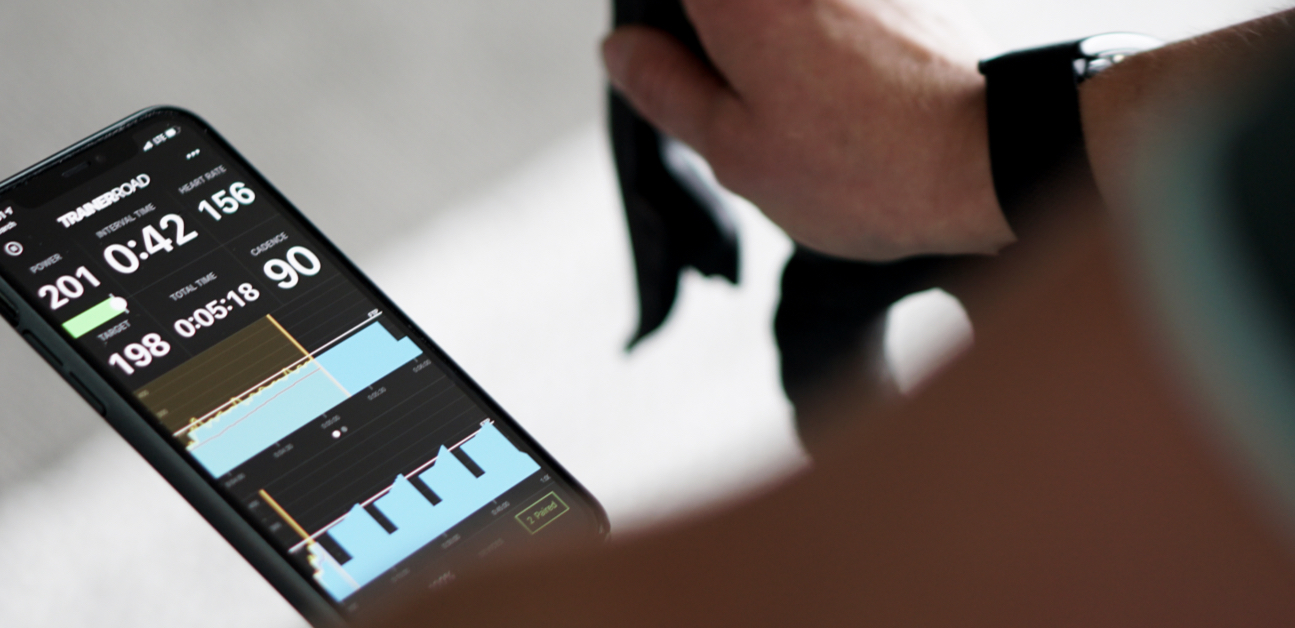
To become a faster cyclist, there’s an optimal, science-backed training process to follow, and it’s more than just one type of workout. The most efficient and effective method is to train specific energy systems while progressively stressing your body. Progressive cycling training provides the right workouts at the right time, so you can break through and reach your goals.
How to Get Faster
Getting faster on the bike is simple at face value—disrupt your body’s state of equilibrium or physiologic homeostasis and adapt. The most effective way this is achieved is through progressive training, which is the foundation of the Base, Build, Speciality Cycle.
Adaptive Training
Get the right workout, every time with training that adapts to you.
Check Out TrainerRoadDisrupting homeostasis can be achieved in many ways. But all of them are stressful in one way or another. Whether through high-intensity intervals or extended mild efforts, some type of stress that challenges your body’s current capabilities needs to occur. As your body adapts, it establishes homeostasis at a greater level of physical ability. Now, only a higher level or different form of stress will disrupt this new level of equilibrium.
Progressive Overload
This means that the same workout that initially prompted adaptation will no longer exert enough stress to inspire further adaptations. Your body must be continually and increasingly challenged (and then rested) to become stronger, faster, and more capable. This is the principle of progressive overload.
Progressive overload is the idea that your workouts should increase in their level of difficulty. This can be achieved with higher power targets, longer intervals, less rest in between intervals, or a combination of all three. Additionally, this increase in stimulus should be just enough to push your current limits, but not so much that it overwhelms you. This means that not every workout has to be one that extremely challenging.
Every TrainerRoad training plan is constantly in the process of being improved to achieve an optimal level of progressive overload. With the addition of Workout Levels (more on these below), you can now see how your workouts are progressing in difficulty throughout your training plan.
Weekly training load can only increase so far before you reach a temporary plateau. More of the same quantity and type of stress is unlikely to elicit further positive adaptation, and your fitness will level off. Additionally, you want to develop the specific fitness needed for your goal events. So what is the solution? Progressive training is the answer.
What is Progressive Training?
Progressive training is the best way to develop the specific fitness you need for your goal event. It does this by stressing the right energy systems to drive adaptations at the correct times of your season. Progressive training begins by building general base fitness, then layers on more specific work, eventually bringing your overall fitness to a well-timed peak. This is the Base, Build, and Speciality cycle.
TrainerRoad’s plans use the principle of progressive training. This means that each plan disrupts your physiologic homeostasis by using progressively higher levels or different forms of stress as you work through the Base, Build, and Speciality Phases. Typically, we use Training Stress Score (TSS) as a way to quantify our training. It’s a good metric, but it doesn’t tell us the whole story because TSS doesn’t reveal the type of stress.
Workout Levels
Workout Levels are a new metric from TrainerRoad that goes beyond TSS to compare the relative difficulty of workouts within each energy system and training zone. They range from 1 to 10, with 1 being easiest and 10 being the hardest. They utilize Adaptive Training’s data-driven insights and incorporate nuanced factors such as repetition, interval length, and recovery time—precisely what you need for progressive training.
Because TSS doesn’t give us the full picture of our training, Workout Levels are beneficial because they give more nuance for tracking our progression. Short Power Build (Low Volume) offers an example of how this works. The first VO2 workout in this plan Sleeping Beauty +3, which is Level 4.3 and 67 TSS. The plan’s next week includes Clouds Rest +3 (Level 4.7, 95 TSS), and a week later Thimble (Level 5.2, 73 TSS).
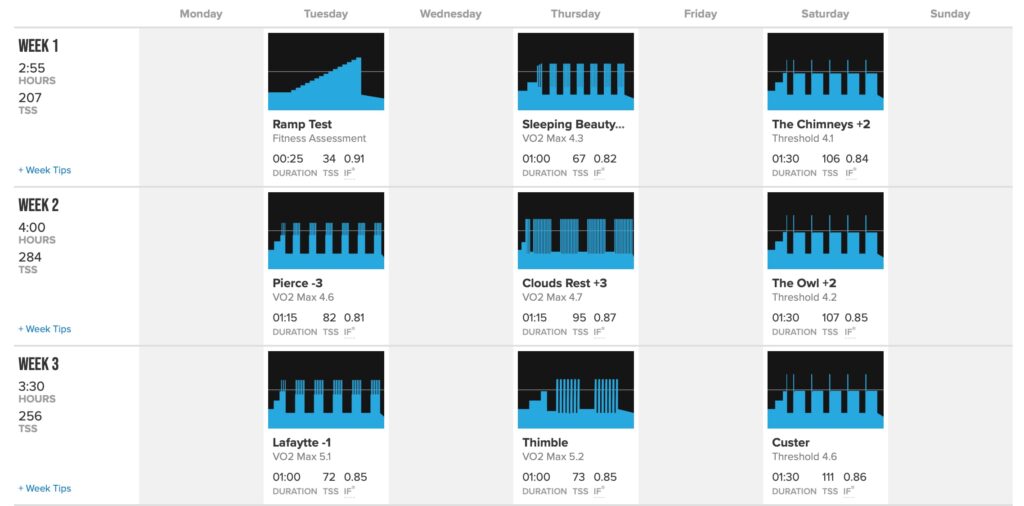
Based on TSS alone, it might look like these workouts start easier, rapidly increase in difficulty, then get easier again. However, the work and recovery interval structure means each is a bit more challenging than the last. The TSS actually goes down for the third workout, but the difficulty increases. Using Workout Levels allows a natural progression from week to week, and provides the progressive overload needed to get faster.
Time in Zone
Another way to examine the progressive nature of a training plan is to view time in zone. Let’s take a look at an example of a 28-week, mid-volume training plan. This training plan progresses through Sweet Spot Base, General Build, and Rolling Road Race Speciality.
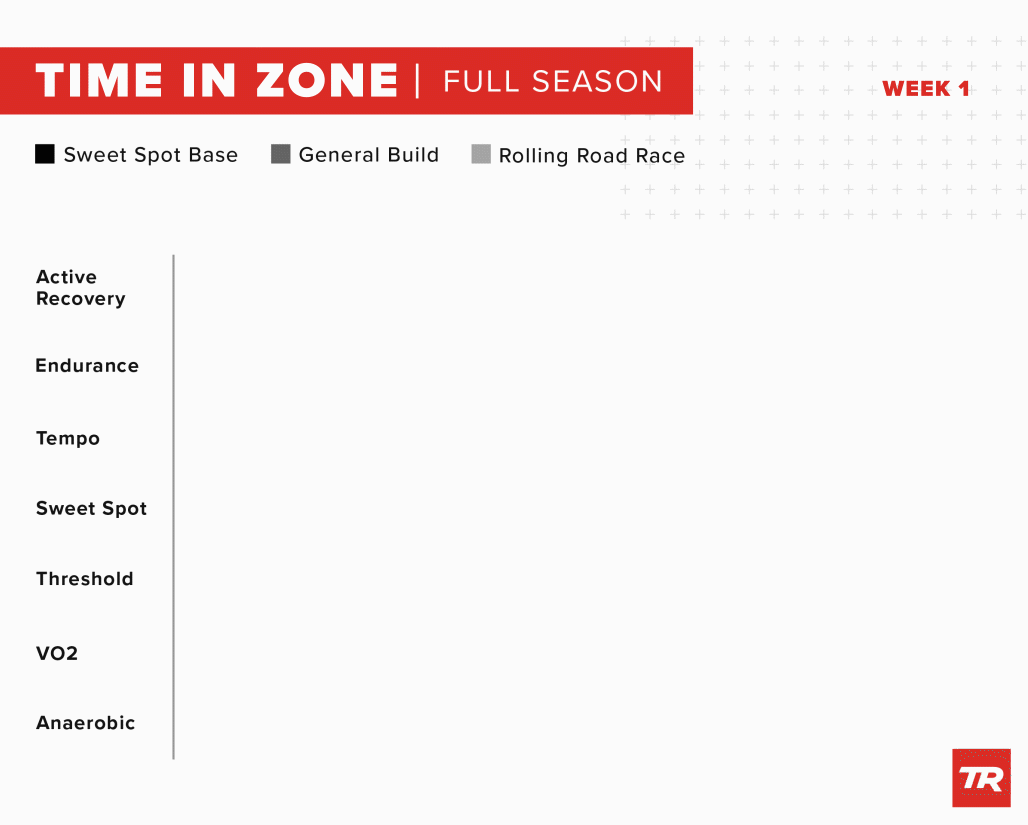
Here we can see the time accrued in each training zone and how the emphasis changes over time. Perhaps most noticeable is the time spent in the Active Recovery and Endurance zones versus the high power zones. Time in those zones is accumulated at an increased rate because every workout features a warmup, cooldown, and rest intervals. Additionally, the end of each training block features a recovery week that features endurance workouts.
Base Phase Training
The goal of the Base Phase is to strengthen your aerobic energy system, growing your base fitness. Interval training has been proven time and again (and again) to elicit similar levels of aerobic adaptation in less time. This is why we recommend Sweet Spot Base to the vast majority of cyclists.
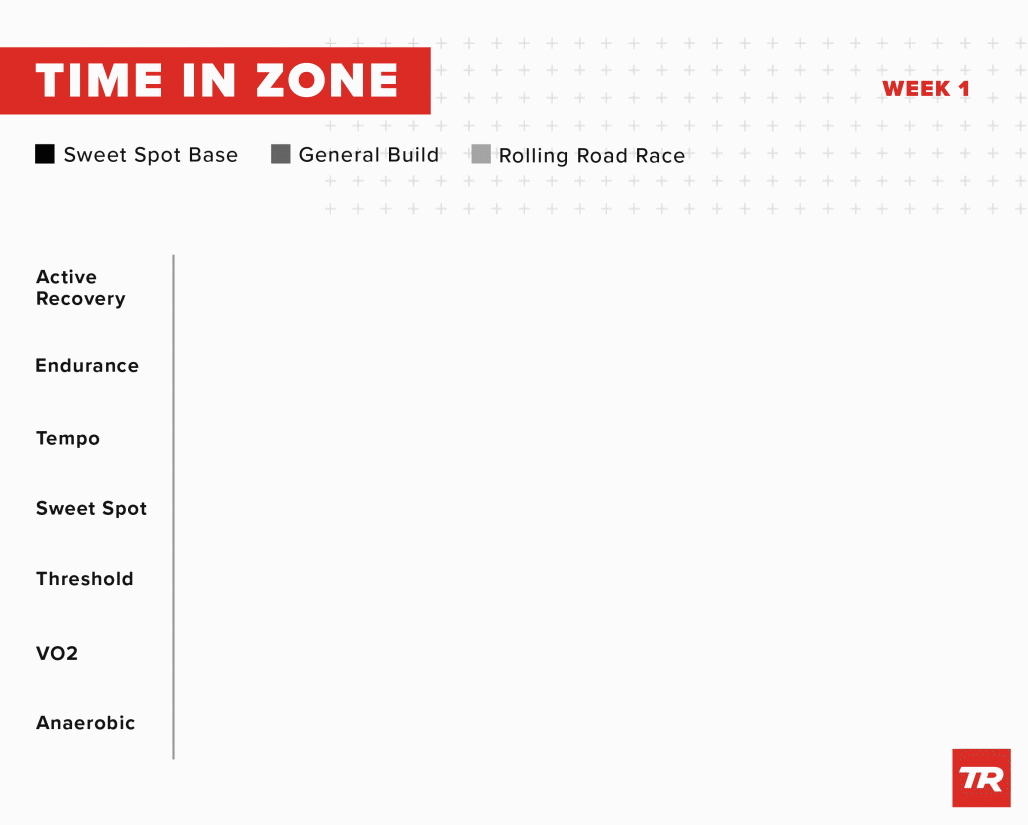
During twelve weeks of Sweet Spot Base, the emphasis on growing base fitness means that most time is spent in the aerobic training zones. Time in the Sweet Spot zone will cultivate adaptations in less time when compared to endurance rides alone. In the last half of Sweet Spot Base, weekly V02 Max workouts raise the intensity level to drive more aerobic adaptations.
By incrementally escalating the weekly training load, improvement in your base fitness is all but assured. But that assumes that this progressive workload balanced with adequate recovery, something we’ve built into every one of our training plans regardless of the training phase.
Build Phase Training
During the second phase of training, the Build Phase, each type of workout takes on a more event-specific form. Greater emphasis is placed on escalating the weekly stress load with more event-specific work than during the Base phase.
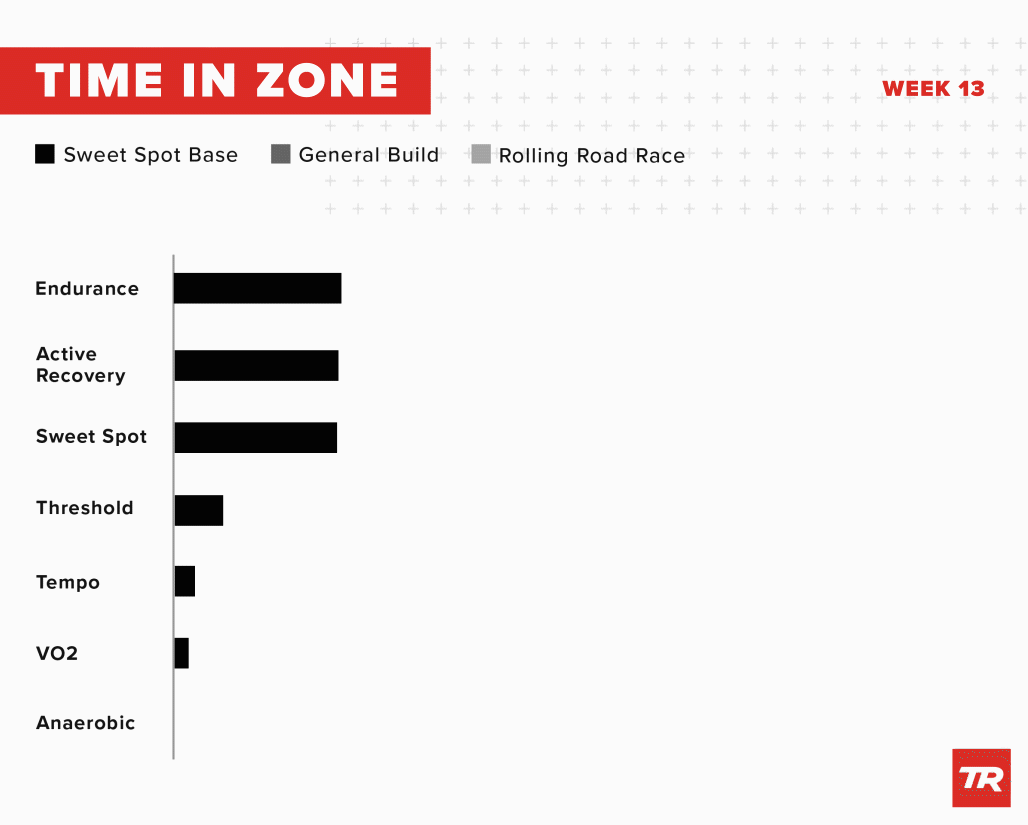
Looking at the graphic, you can see the introduction of anaerobic work and increasing time spent in both V02 Max and Threshold zones. During the Base Phase, 28% of training time is in the Sweet Spot zone. During General Build, that drops to about 14%, making room for higher intensity work.
The Build Phase focuses on increasingly event-specific training to improve more relevant types of fitness. Aerobic base fitness is merely maintained via sweet spot workouts. The Build phase allows you to heighten your training specificity level and bring your fitness to a point where middle-priority events can factor in weekly training.
Specialty Phase Training
Finally, during the Specialty phase, the overall stress load declines slightly to restore a higher level of race preparedness. At the same time, the workouts shift their emphasis from building further fitness to honing the established fitness into its most event-specific forms.
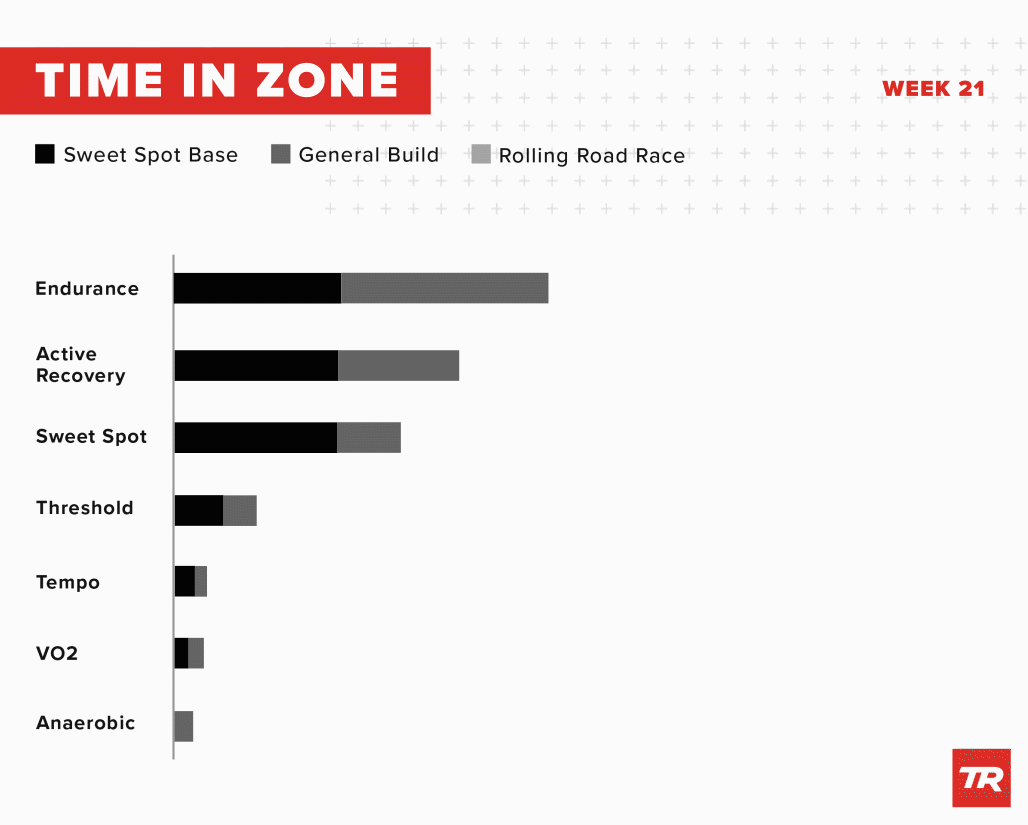
This is where the workouts reach the height of their intensity, but each week’s training volume experiences a mild decline. During Rolling Road Race Speciality, the percentage of time in both V02 Max and Anaerobic zones increase compared to the Build Phase. To prepare you for the repeated attacks in a road race, you’ll spend almost 8% of your time in the anaerobic training zone.
This becomes a delicate balance between workouts bent on truly testing your event readiness while gradually trimming the overall training stress to a point where your best performances can be realized. By subjecting you to the most challenging workouts in the entire Base, Build, Speciality cycle, the Specialty phase aims squarely at top performances in the highest-priority events.
More On Cycling Training:
References
- Gillen, JB., Gibala, MJ., ( 2014, March). Is high-intensity interval training a time-efficient exercise strategy to improve health and fitness?. https://www.ncbi.nlm.nih.gov/pubmed/24552392
- Gibala, MJ., Jones, AM., (2013). Physiological and performance adaptations to high-intensity interval training. https://www.ncbi.nlm.nih.gov/pubmed/23899754
- Tjonna, AE., Leinan, IM., et. al., (2013 May). Low- and high-volume of intensive endurance training significantly improves maximal oxygen uptake after 10-weeks of training in healthy men. https://www.ncbi.nlm.nih.gov/pubmed/23734250
- Gibala, MJ., Little, JP., Macdonald, MJ., Hawley, JA., (2012 March). Physiological adaptations to low-volume, high-intensity interval training in health and disease. https://www.ncbi.nlm.nih.gov/pubmed/22289907
- Skelly, LE., Andrews, PC., Gillen, JB., et. al., (2014 July). High-intensity interval exercise induces 24-h energy expenditure similar to traditional endurance exercise despite reduced time commitment. https://www.ncbi.nlm.nih.gov/pubmed/24773393
- Zimmer, P., Bloch, W., Schenk, A., et. al. (2017 August). High-intensity interval exercise improves cognitive performance and reduces matrix metalloproteinases-2 serum levels in persons with multiple sclerosis: A randomized controlled trial. https://www.ncbi.nlm.nih.gov/pubmed/28825348
For more cycling training knowledge, listen to Ask a Cycling Coach — the only podcast dedicated to making you a faster cyclist. New episodes are released weekly.